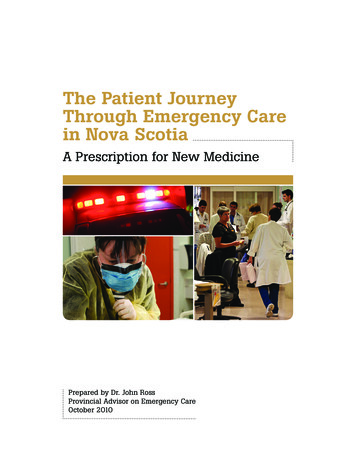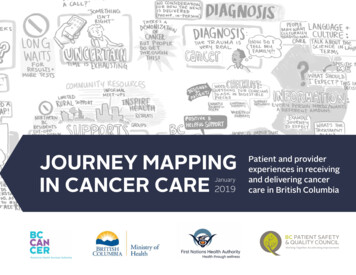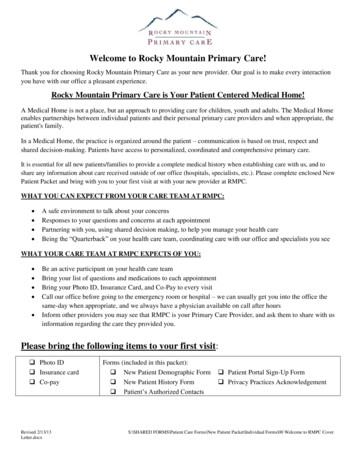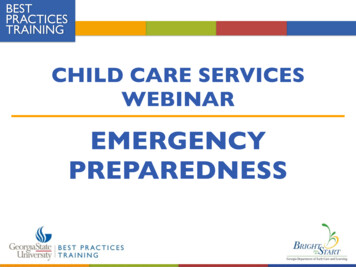
Transcription
The Patient JourneyThrough Emergency Carein Nova ScotiaA Prescription for New MedicinePrepared by Dr. John RossProvincial Advisor on Emergency CareOctober 2010
The Patient JourneyThrough Emergency Carein Nova ScotiaA Prescription for New Medicine
“Many years ago, I sat down with the administrators ofa major hospital to think through the mission statementof the emergency room. It took us a long time to comeup with the very simple, and (most people thought) tooobvious statement that the emergency (department) wasthere to give assurance to the afflicted.The doctors andnurses GIVE ASSURANCE.We worked it out, but it sounded awfully obvious. Yettranslating that mission statement into action meantthat everybody who comes in is now seen by a qualifiedperson in less than a minute some people are rushedto intensive care, others get a lot of tests, and yet othersare told don’t worry But the first objective is to seeeverybody, almost immediately—because that is the onlyway to give assurance.”1 Peter F. Drucker1Peter Drucker. Managing the Non-Profit Organization. Oxford: Butterworth-Heinemann, 1990.
ContentsExecutive Summary.viiSummary of Recommendations. xvBackground. 1Mandate.1A Brief Review of the Interim Report.1A Caution About Disease Care, Health Care, and Patient-Centred Care.2The Journey.5The Symptoms. 7The Diagnoses. 9The Treatment. 29Recommendations for Funding and Standards.29Recommendations for Bigger and Smaller Hospitals.32Recommendations for Emergency Health Services (Paramedics).67Recommendations for Seniors’ Care.71Recommendations for Mental Health Emergencies.74The Way Forward.77Appendix 1: Envisioning Patient-Centred Care.79Glossary of Terms.81References. 83A Prescription for New Medicinev
Executive SummaryExamination of the ProblemIn September 2009, the Nova Scotia government appointed Dr. John Ross—a 20 yearveteran emergency physician—as its first provincial advisor on emergency care. Overthe past year, Dr. Ross visited or spoke with staff from every Emergency Department(ED) in the province. He talked with doctors, nurses, paramedics, and other healthcare workers; district health authority management and board members; communityhealth boards; and civic leaders, citizen groups, and patients.In summary:“.most residents of this province have become accustomed to a level of access and quality that is lessthan what Nova Scotians deserve. . When they cannot get in to see their family doctor for six weeks—acommon enough occurrence—they conclude ‘I guess that is the way it is.’ Then they thank their goodfortune at having an Outpatients Department nearby where they can at least go to see a physician.Ironically, the doctor they finally see in the Emergency Department may be the same family doctor theycouldn’t get in to see earlier that day at their office. This is not how the ‘system’ is supposed to work.”In this report, the symptoms and diagnosis of a system not working are presented.The Emergency Department is simply the canary in the coal mine, alerting people tothe troubles that are putting the entire health care system at risk.Finally, this report prescribes the treatment—recommendations to make the “patientjourney” work the way it should—for patients, of course, and for all who care for them.Symptoms and DiagnosisIn conversations with hundreds of people, common themes recurred. People wait too long for emergency care and to see their doctor. People are confused about where to go if they have a medical problem. People are afraid of losing existing health services. People have a limited understanding of paramedics’ knowledge and skills, and areconcerned about the cost of calling an ambulance. Access to mental health services is limited. People trust their doctors and nurses, but distrust District Health Authorities and theDepartment of Health. People want more doctors and nurses hired.A Prescription for New Medicinevii
The report presents common myths that have grown in the absence of factualinformation. These myths deal with how the different parts of the health care systeminteract (or don’t interact) with each other; how the system is funded; how staff areworking and trained; and who is going to Emergency Departments, and why.The TreatmentIn response to the concerns identified, recommendations are offered relating to six areas:funding and standards; bigger hospitals; smaller hospitals; Emergency Health Services(paramedics); care for seniors; and mental health emergencies.For Funding and StandardsUse standards to set the bar for delivering quality care. Make quality of patientcare and performance the basis for funding.Funding should be performance-based and linked to improved health outcomes,while remaining fiscally responsible. As well, patient- and provider-centred fundingmodels must be developed to promote better health outcomes and supportrecruitment and retention. The province paid doctors 661 million in 2009 and isexpected to pay 699 million in 2010–11. Everyone—including doctors—wants toensure health outcomes are improving as a result of this investment.No standards exist for emergency care anywhere in Canada. Standards will raise thequality of emergency care and bring consistency to every region. Nova Scotia shouldbe the first province to adopt and meet them.For Bigger HospitalsMove patients out of Emergency Departments sooner.It will ease overcrowding and reduce wait times.In bigger hospitals, the major problem is overcrowding.Some patients need more options, including same-day or next-day primary-careappointments and after-hours clinics. People requiring emergency care need tobe discharged or moved to a hospital bed as quickly and safely as possible oncethe emergency is stabilized, in order to accommodate those who have not yetbeen assessed.Moving patients into special-purpose areas can speed patients’ access to a decisionmaker. For example, “fast-track” areas can be available for assessing and treatingminor injuries and illness. Some common diagnostic tests could be performed byviiiA Prescription for New Medicine
staff in the fast-track areas. X-rays and other common tests for emergency patientsshould be considered high priority by the hospital. Other types of providers should beconsidered to work with doctors in the Emergency Department.The new Rapid Assessment Unit at the Halifax Infirmary allows patients who arewaiting for specialist consultations to be diverted out of the Emergency Department,to ease overcrowding and reduce wait times.Most people who go to Emergency—85 to 90 per cent—are not admitted to hospital.The 10 to 15 per cent who do require admission, however, stay in the EmergencyDepartment for hours or days. That prevents the department from functioningeffectively. Patients do not receive timely assessment and are left worrying thatthey have a serious condition that will get worse. Some have simple conditions thatnonetheless need a few moments of medical expertise. In all cases, tens of thousandsof hours of peoples’ valuable time is spent waiting.Other recommendations include: staggering shift changes so all staff aren’t leaving and arriving at once improving communications with patients who are waiting, as well as among hospitalstaff, paramedics, and outside agencies (e.g., those offering home care) reviewing and changing the roles of everyone who works in and around theEmergency Department, so everyone’s experience and skills are being used to theirfullest extent training more experts in emergency care staffing Emergency Departments to meet patient needs, including moving staff fromother parts of the hospital to cover for staff who are sickFor Smaller HospitalsIn communities with small hospitals, provide better access to primarycare, including same-day or next-day appointments.Almost 90 per cent of visits to small Emergency Departments are for problems thatcould be adequately treated in a clinic setting, and most of those visits occur duringthe day and evening. Random Emergency Department closures cause confusion andconsiderable concern if there are no other options.Emergency Department closures create uncertainty:In 2009-10, Emergency Departments were closed for more than 19,000 hours—orthe equivalent of 795 days—province wide.A Prescription for New Medicineix
As in larger hospitals, many patients go to emergency or outpatient services insmaller hospitals because they cannot see their doctor. Many communities reported asix-week wait for a doctor’s appointment. Improving access to primary care—doctors,nurse practitioners, mental health workers, or other primary caregivers—is a vital partof health-care reform.Vast majority of visits are for non-emergency careThe public expectation is thatthe staff in any EmergencyDepartment will render expertcare. However, it is very difficultfor doctors and nurses to maintaintheir emergency care skillswhen they rarely managesevere emergencies.Night-time visits are rareSummary of visits to one smallerEmergency Department, 2009–10 (see p. 49).One smaller hospital averagedabout one patient per night.Then the on-call doctor and nursemay not be available to workthe next day. Are valuable staffbeing used effectively when mostpeople need them during the dayand evening?xA Prescription for New Medicine
Overnight shifts are costly:The average cost to taxpayers for having doctors on overnight emergency call forsmall hospitals is 350,000 to 700,000 per year per site.But serious emergencies DO occur and people must have quick access to the carethey need. Primary and emergency care can be provided far more effectively than it istoday. The public can gain far better access to appropriate primary care, while havingreliable and predictable emergency care when it is needed.We need to develop more clinics that deliver primary care and chronic diseasemanagement through open access (same-day or next-day appointments) andcollaborative teams of doctors, nurses, and allied health providers. This is alreadyhappening in parts of Nova Scotia.Minor emergency care can be provided in Community Health Centres and smallhospitals that have collaborative teams under one roof (a Collaborative AssessmentRoom for Emergencies, or CARE). Major emergencies should be cared for andtransported by Emergency Health Services (EHS) directly to the most appropriateregional or provincial hospital in the shortest time possible. The cost of EHS use mustbe addressed.Aside from services on-site, nurses working with Health Link 811 can provideadvice on minor emergency care. As well, paramedics can provide basic care duringhome assessments, arrange clinic follow-up, or provide more advanced care whiletransporting patients to hospital.Developing innovative on-call systems by leveraging current technology must be partof the solution. This will free up more doctors to provide daytime care, while ensuringpatients in every community can get the emergency care they need. This shouldalso include using Telemedicine technology to link experienced doctors with otherproviders who can provide care even when a local doctor is not on site.Each community is distinct, yet all are passionate about their health care. There is notone solution that fits all communities. A community’s energy and ideas must be thedriving force as ‘full service’ Community Health Centres are formed.A Prescription for New Medicinexi
For Emergency Health Services (Paramedics)Use paramedics to bring advanced emergency care to where people liveand work.Emergency Health Services-—delivered by highly trained paramedics who can bringlife-saving care to people’s doorsteps—must also be enhanced. And when paramedicsbring patients to hospital, they should be able to get patients into the EmergencyDepartment quickly—within 20 minutes for 9 out of 10 patients. Some alternativesto using paramedics for routine transfers should also be examined, in the interest ofmaking the best use of valuable paramedics’ time.For Seniors’ CareGive seniors the care they need in the right place.A visit to the Emergency Department creates anxiety for anyone. Imagine the addedstress of the noise, bright lights, and rapid pace when the patient is elderly. With this inmind, all Emergency Departments should analyze their processes, physical layout,and approach.Many seniors land in Emergency Departments when what they really need is careprovided in their home or nursing home. Improving access to these services should bea priority.For Mental Health EmergenciesUse Emergency Departments as an uncommon exception.Mental health patients often end up in Emergency Departments because it is “thepath of least resistance.” Yet they would be better served outside the EmergencyDepartment. Providing greater access to mobile crisis teams across the province isrecommended. The government’s commitment to creating a provincial mental healthstrategy is also welcomed.xiiA Prescription for New Medicine
Prognosis: There is hopeIn larger hospitals, people want to see and experience shorter wait times in theEmergency Department. This requires better collaboration of primary care providers(more evening access), whole-hospital flow improvement, and collaboration withContinuing Care. It is absolutely possible, but it requires clear leadership and theright incentives.In smaller communities, Nova Scotians fear losing the defining element of theirhospital—their Emergency Department—in some cases after having already lostsurgery, obstetrics, and other services.This report is about GAINS, not losses. Shorter wait times in larger EmergencyDepartments. Same-day or next-day access to doctors and other care providers thatcan meet the needs of the vast majority of patients. Emergency care available to all.A Prescription for New Medicinexiii
Summary of RecommendationsFor Funding and StandardsUse standards to set the bar for delivering quality care. Make quality of patientcare and performance the basis for funding.1.Forge a new health care funding path.2.Develop innovative patient-centred and provider-centred funding models forphysicians.3.Adopt the recently developed Emergency Department Standards.For Bigger HospitalsMove patients out of Emergency Departments sooner. It will ease overcrowdingand reduce wait times.4.Provide better access to primary care to take the pressure off EmergencyDepartments.5.Stream emergency patients into special-purpose areas.6.Stagger shift changes and offer more shifts of varying lengths.7.Improve communication with people who are waiting and among hospital staff,EHS (paramedics), and outside agencies.8.Give non-traditional providers a bigger role in the emergency health system.9.Produce more specialists in emergency care.10. Staff the Emergency Departments to adequately meet patient needs.11. Ensure that at least 90 per cent of admitted patients are in the EmergencyDepartment less than eight hours.12. Use information technology to track and enhance the patient journey.For Smaller HospitalsIn communities with small hospitals, provide better access to primary care,including same-day or next-day appointments.13. Make access to primary care a priority.14. Make emergency care a seamless part of primary care.15. Consider an evolution of select Emergency/Outpatient Departments to aCollaborative Assessment Room for Emergencies (CARE) model.A Prescription for New Medicinexv
16. Develop very clear policies around hours of operation, ensuring the priority ofpatient safety at all times.17. Consider an innovative on-call system for clinicians.18. Harness the energy and capacity of communities.19. Communicate, communicate, communicate.For Emergency Health Services (Paramedics)Use paramedics to bring life-saving care to where people live and work.20. Improve the ambulance patient offload time to 20 minutes, 90 per cent ofthe time.21. Develop shuttle services for select hospital transfers to maximize the use ofthe paramedics’ scope of practice.22. Better coordinate the movement of patients between facilities to make thebest use of resources.For Seniors’ CareGive seniors the care they need in the right place.23. All Emergency Departments should analyze their processes, physical layout, andapproach through the lens of an elderly, confused, and scared patient.24. As continuing care becomes a responsibility of District Health Authorities (DHAs),all DHAs should support proactive alternatives to emergency and acute care.25. People over the age of 75, who are frail and see a primary care clinician, should beassessed using the Comprehensive Geriatric Assessment Tool.For Mental Health EmergenciesUse Emergency Departments as an uncommon exception.26. Provide access to more Mobile Crisis Teams in Nova Scotia.xviA Prescription for New Medicine
BackgroundMandateNova Scotians should expect to have timely access to emergency services thatincludes getting quickly to the most appropriate emergency health-care provider.As the Provincial Advisor on Emergency Care, I have been tasked with leadingemergency care improvements with the goal of significantly improving thedelivery of emergency services in Nova Scotia.The purpose of my current review is to visit individual communities within DistrictHealth Authorities (DHAs), listen to local concerns, find common themes, anddevelop a provincial strategy for the whole emergency services system insteadof the current individual temporary solutions that have occurred over time. I havemet many experienced, knowledgeable, and caring people in Nova Scotia whotogether can supply the answer: the Advisor role is to collect those solutions,acting as a voice for the people I have met, and present them to the DeputyMinister and the Minister of Health.(Mandate statement from the Interim Report, April 2010)2A Brief Review of the Interim ReportIn Emergency Care in Nova Scotia: Interim Report, released in April 2010, seven mainthemes were highlighted under ‘What I Learned’:1.Create provincial Emergency Department standards.2.Improve access to primary care.3.Address wait times at regional and referral hospital Emergency Departments.4.Improve emergency care of the elderly.5.Identify and address the role of the hospital Emergency Department as a socialsafety net.6.Improve access to emergency mental health care.7.Develop reliable data—in the process ensuring improved and transparent dataaccess and analysis—to inform decisions.2John Ross. Emergency Care in Nova Scotia: Interim Report. Nova Scotia Department of Health: April 2010A Prescription for New Medicine1
Since the April report, visits and follow-up have occurred with health districtsaround Nova Scotia. During visits to over 30 sites with Emergency Departments, Iheard valuable opinions and recommendations from Emergency physicians, familyphysicians, internists, surgeons, radiologists, nurses, paramedics, social workers, mentalhealth staff, dieticians, pharmacists, physiotherapists, managers, vice presidents,chief executive officers, District Health Authority board members, Community HealthBoard members, and citizens from around the province. By listening to the opinionsof people who work near the “coal face,” I now have a better understanding of whatworks and what does not. Some advice has recurred over and over, confirming itsimportance and value. Innovators in Ontario, British Columbia, and Saskatchewan havealso contributed experiences and advice. As well, numerous reports published by abroad range of groups in North America, the United Kingdom (UK), and Australia haveinfluenced this report. I heard many good ideas about how Nova Scotia can invest itstax dollars more wisely, given our population of just over 940,000 and an annual healthcare budget of 3.4 billion.Despite 20 years as a full-time Emergency physician, educator, and administrator, thishas been a year of profound learning and reflection. My clinical career has been basedin a busy urban teaching centre. Over the years, I have been honored to work withhighly skilled people in Halifax and also across the province as a Trauma Team leaderand instructor, Life Flight physician, Poison Centre consultant and airway proceduresinstructor. While working on this report, I have been both gratified and humbled tomeet with so many dedicated people—clinicians, DHA executive teams and boards,and Community Health Boards—who profoundly care about making our health-caresystem better for patients. Much of this report is composed of their ideas and opinions,collected during meetings and interviews across Nova Scotia. The public shouldbe confident: visionary leadership exists and great ideas are out there. We are ingood hands.A Caution About Disease Care, Health Care, andPatient-Centred CareHealth-care services for Nova Scotians are usually referred to as the “health-caresystem.” In this province, as in every other province in Canada, that term is a misnomer.Its use contributes to some of the problems facing emergency care in this province.In truth, we have a “disease-care non-system.” Clear language is necessary to sort andcompartmentalize the issues that require resolution.A landmark 1974 report by Marc Lalonde, Minister of National Health and Welfare,was one of the first documents to point out that Canada’s emphasis on a purelybiomedical “health care” system is wrong. Instead of being consumed by increasinglysophisticated and expensive sickness and disease care, A New Perspective on the Healthof Canadians3 recommended placing a new emphasis on four broad elements—2A Prescription for New Medicine
human biology, environment, lifestyle, and health-care organization—as the keys tohealth. From the report’s point of view, true “health” exists outside, rather than within,the traditional and existing “health care” system. The report placed an increased onuson individuals to change their behavior and take responsibility for disease preventionand true health promotion. It also recommended identifying the segments of thepopulation at highest risk for disease, and focusing attention on them.It is staggering to read the report 36 years later and see, now as then, virtuallyidentical descriptions of preventable diseases and the resulting hospitalizations anddeaths. Unfortunately, the report’s sage advice has been largely ignored. Most of theCanadian “health care” system is managed and delivered by professionals who aretrained in the “disease care” model. Medical and nursing training programs spendlittle time on prevention and health promotion. Instead, the health-care professionalsof tomorrow are trained in a type of reactive disease care, which strives endlessly formore expensive diagnostic tools and treatments. The word “system” refers to a set ofinteracting or interdependent entities forming an integrated whole. Our system simplydoes not meet those criteria.Our population is trained to believe that magical things can happen in hospitals.The public is left to believe that those of us who practice the magic art of medicinecan diagnose and undo all the stresses and strains of today’s society. A test, pill, oroperation absolves us of responsibility for managing our own affairs. We can eat toomuch fried food, avoid exercise, abuse alcohol and drugs, drive too fast without seatbelts or bike helmets, and take on increasingly higher levels of stress, and still expectthe system to take care of us when totally predictable—and fully preventable—illnessand injuries occur. We want our system to be all things to all people all the time. Mostlythis unsustainable disease-care “non-system” is anything but.Anyone who has been a patient or accompanied a patient to an EmergencyDepartment quickly discovers that the realm they are entering is dysfunctional—anon-system if you will: multiple specialty groups that do not communicate witheach other; multiple delays and hand-offs; partial data; little accountability; and, inthe end, limited evidence that all these investments and activities produce thedesired outcomes.There is a better way. Several excellent recent reports have nicely summarized thequalities of patient-centred care (PCC). The Ontario Medical Association policy papersums up patient-centred care as “a system where patients can move freely along a carepathway without regard to which physician, other health-care provider, institution orcommunity resource they need at that moment in time. This system is one that wouldconsider the individual needs of patients and treat them with respect and dignity.”434Marc Lalonde, A New Perspective on the Health of Canadians: A Working Document. Government of Canada, 1974.Hanna, A. “Patient-Centred Care,” Ontario Medical Review (June 2010): 34.A Prescription for New Medicine3
In his 2009 report to the Saskatchewan government, Steven Lewis, a respected healthpolicy advisor, highlighted the following characteristics of patient-centred care:51.Respect for patients’ values, preferences and expressed needs.2.Coordination and integration of care.3.Information, communication, and education.4.Physical comfort.5.Emotional support.6.Involvement of family and friends.7.Delivery systems that provide for caring hand-offs between different providersand phases of care.PCC is talked about in many disease-care settings. Unfortunately, it has becomemore of a slogan than a practice or the foundation of a strategy. Instead, much oftoday’s disease-care system is provider-centred—designed for the convenience ofthe practitioners. By that measure it is a rousing success. Patients, however, have adifferent perspective. (See Appendix 1.)After visiting almost every Nova Scotia community with an Emergency Departmentor “outpatients” unit, I’ve concluded that most residents of this province have becomeaccustomed to a level of access and quality that is less than what Nova Scotiansdeserve. They are afraid to question the availability or the quality of our doctors andnurses for fear that those providers become offended and leave. When they cannotget in to see their family doctor for six weeks—a common enough occurrence—theyconclude “I guess that is the way it is.” Then they thank their good fortune at havingan outpatients department nearby where they can at least go and see a physician.Ironically, the doctor they finally see in the Emergency Department may be the samefamily doctor they couldn’t get in to see earlier that day at their office. This is not howthe “system” is supposed to work.True patient-centred care is possible if the disparate services and providers trulyembrace the concept and use it as the unifying principle to create an interdependentsystem. Nova Scotia’s primary health-care professionals are working to make this areality. This report attempts to use true people-centred care as the principle on whichto rebuild emergency care.5Steven Lewis, Patient-Centred Care: An Introduction to What It Is and How to Achieve it – A discussion paper for the SaskatchewanMinistry of Health. 2009. p. 1.4A Prescription for New Medicine
The JourneyThe report is called “the patient journey” because, in the simplest terms, caring for patients iswhy a coordinated system was needed in the first place. First came the sick person; secondcame the caregiver. As the number of sick people and caregivers increased, a system thatcould support them was needed. And yet fast forward to 2010 and the natural order ofthings has been reversed. We have allowed the system to see the patient more as a burdenthan its very reason for being. To some, patients are ‘cost drivers’ and to others they borderon being nuisances who get in the way of a smoothly functioning bureaucracy.The shift has been gradual. In the middle of the 18th century the origins of diseases andtheir treatments began to be discovered. Also, doctors began dividing the body intoseparate functional groups. The medical and surgical specialties evolving from thisprocess have greatly advanced our ability to diagnose and treat disease. But, they havealso resulted in separate silos that do not communicate and rarely consider the patientas a whole. Patients, as a result, are left to make their way through and between theseopaque and incomprehensible specialists’ silos with little help from practitioners whoare sometimes unsure how their own area is supposed to function, let alone how tonavigate the larger path ahead.The automobile giant Toyota, over time, perfected the complicated process of linking aseries of specialists along an assembly line. They created a culture of cross-functionalteams in which anyone along the line could stop the
In September 2009, the Nova Scotia government appointed Dr. John Ross—a 20 year veteran emergency physician—as its first provincial advisor on emergency care. Over the past year, Dr. Ross visited or spoke with staff from every Emergency Department (ED) in the province. He talked with doctors, nurses, paramedics, and other health-










